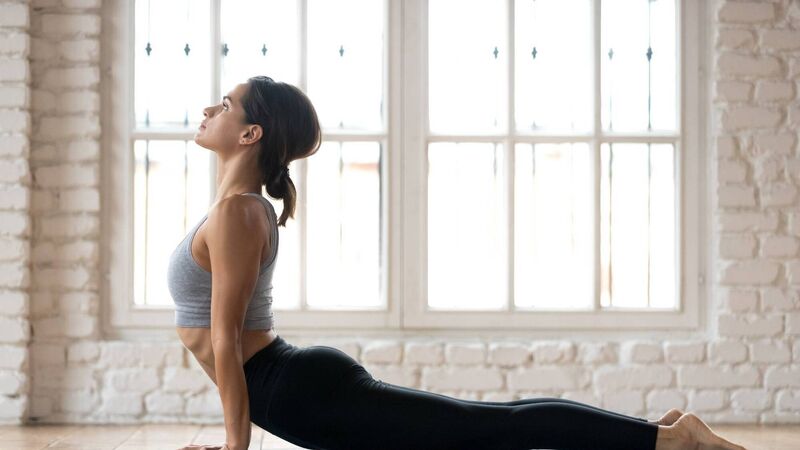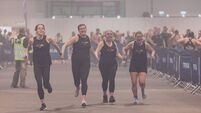Put your back into it: Does exercise actually ease chronic back pain?

DEEP STRETCH: Yoga can be helpful for people with back pain. Picture: iStock
About 80% of adults experience back pain at some point in their lifetimes and, according to the Irish Health Survey conducted by the Central Statistics Office, it is the most commonly reported chronic health condition in the country.
Of all the remedies and treatments that promise to ease it, exercise is considered among the most helpful. But while there’s little doubt that physical activity will improve back mobility and core strength, the authors of a new paper published in the journal suggest that many of the pain-relieving effects of exercise induces are largely in the mind.
Daniel Belavy, professor of physiotherapy at the University of Applied Sciences (Hochschule für Gesundheit) in Bochum, Germany, and Dr Clint Miller, a lecturer in clinical exercise physiology at Deakin University in Australia found that the benefits of exercise on easing discomfort for sufferers of chronic muscle pain are no better than sham placebo treatments such as fake pills, creams and injections.
They say that the results of their meta-analysis of 79 studies involving 4,719 patients don’t mean that people with back and muscular pain should avoid working out, but that mystery still surrounds how and why exercise might be working.
“Exercise can and does have known physiological effects on strength, function and endurance of muscles, and it is an effective therapy for musculoskeletal conditions,” Belavy says. “But we only looked at exercise effectiveness on pain and discovered exactly how much of its benefits are determined through placebo-related effects is still open to question.”
His findings were an eye-opener. “It is clear from previous studies that placebo effects play a role in all healthcare interventions from massage to acupuncture, so we were prepared to see some component of that with exercise,” he says. “However, that the placebo effect of exercise is so large was a bit surprising”.
It’s not the first time that researchers have attempted to unravel the puzzle of how physical activity eases pain. Last year, a team from the University of New South Wales and Neuroscience Research Australia (NeuRA) reviewed 110 papers involving more than 7,000 participants to try to find out why exercise works for chronic low back pain (CLBP), defined as pain felt on the back of the body between the bottom of the ribs and the bottom of the backside lasting three months or longer.
Yet Dr Matt Jones, an exercise physiologist, clinician and researcher at the University of New South Wales who led the investigation study in the journal [exa.mn/Exercise-back-pain], admitted he remained baffled to discover there was no clear agreement between scientists about its actions.
“Despite decades of research in the area and more than 100 studies we analysed in our review, we still do not have a good idea of why exercise might be effective for chronic low back pain," Jones says.
Part of the problem is that chronic pain is notoriously difficult to study with so many contributory factors and with each case varying wildly from the next. "With CLBP, it's not simply biological aspects of tissue damage, but there are psychosocial elements at play, as well things like a person's mood or confidence in their own abilities to do something," Jones says.
It is known that exercise has some mood-enhancing and analgesic benefits [exa.mn/Science-Direct]. “It increases your threshold to feel pain,” Belavy says. “And we have reported that this effect increases over time.”
But equally important are the so-called ‘contextual factors’ that produce placebo effects. “The degree of the placebo effect will vary from person to person when it comes to exercise and back pain,” says Belavy. “For example, someone who does not feel comfortable in a gym environment may not experience the same level of pain improvement as someone who enjoys being there.”
What’s certain is that to keep your back healthy, you must keep moving. “Without a level of back fitness, you will eventually experience problems when attempting even everyday tasks.”
Once back pain becomes chronic, the tissue is no longer inflamed and being inactive will tend to reinforce pain sensitivity pathways, says Belavy. “In other words, your pain will feel worse if you do nothing at all. The message remains to find an exercise that works for you and keep at it.”
Wilson says that lifting weights and doing body-weight exercises such as push-ups and squats can boost physical function and emotional health of people with lower back pain. “Our spines are designed to withstand strenuous lifting, including weight lifting, twisting and pushing movements,” she says. Start with basic exercises such as squats and lunges, adding weights as you get more proficient and stronger.
In a 2019 review published in the , Belavy and his colleagues reported anything that “improves the efficiency and capacity of your cardio-respiratory system” is helpful for back pain relief. This includes walking, cycling and jogging and swimming.
Pilates scored well in terms of reducing pain, but Belavy says other core-strengthening workouts are just as good. “Pilates didn’t turn out better than other active forms of exercise, such as stabilisation exercises, which target the trunk muscles, aerobic activity and resistance exercise.”
Wilson says that yoga when done carefully can be helpful for people with back pain. One study of 320 people with back pain showed how a yoga class designed specifically for back pain proved an effective way to improve their symptoms. About 70% of the subjects were taking pain-relief medication at the start of the study, according to the researchers, from the Boston Medical Center. Yet of those who did a weekly yoga class for 12 weeks, the percentage of participants still taking pain medication had dropped to about 50%.

Celebrating 25 years of health and wellbeing








